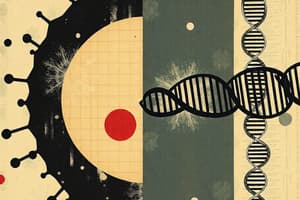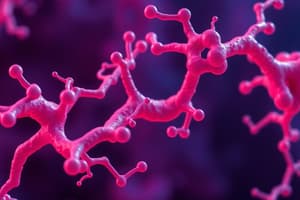Podcast
Questions and Answers
What is cell biology?
What is cell biology?
Cell biology is a branch of biology that studies the structure and function of the cell, which is the basic unit of life.
Which processes are fundamental to cell biology?
Which processes are fundamental to cell biology?
- Photosynthesis
- Mitosis (correct)
- Respiration
- Meiosis (correct)
Molecular biology and cell biology are essentially the same.
Molecular biology and cell biology are essentially the same.
False (B)
What are the three most abundant biological macromolecules?
What are the three most abundant biological macromolecules?
What are proteins composed of?
What are proteins composed of?
How do proteins differ from each other?
How do proteins differ from each other?
Match the following types of proteins with their functions:
Match the following types of proteins with their functions:
What is the primary structure of a protein?
What is the primary structure of a protein?
Flashcards are hidden until you start studying
Study Notes
Cell Biology
- Cell biology is a branch of biology that studies the structure and function of the cell
- Cell biology focuses on physiological properties, metabolic processes, signaling pathways, the life cycle, chemical composition, and the interactions of the cell with their environment
- Includes the processes of mitosis and meiosis
- Molecular biology focuses on molecules of life, primarily nucleic acids and proteins
- Cell biology focuses on how these molecules are used by the cell for survival, reproduction, and normal cell function
Cellular Macromolecules
- The most abundant biological macromolecules are proteins, nucleic acids, and polysaccharides
- These are all polymers composed of multiple covalently linked small molecules, called monomers
Proteins
- Proteins are polymers of amino acids, linked by a peptide bond
- The order in which amino acids occur in a polypeptide chain is specific to each protein
- Proteins are large and highly complex macromolecules
Protein Structure and Function
- Proteins are the working molecules of a cell, carrying out the program of activities encoded by genes
- Proteins are constructed by the polymerization of 20 different amino acids into linear chains
- Proteins differ in kind, number, and arrangement of amino acids they contain
- The structures and functions of proteins are determined by the properties of the amino acids, specifically their side chains
- Side chains vary in size, shape, charge, hydrophobicity, and reactivity
Protein Functional Classes
- Structural proteins provide structural rigidity to the cell
- Transport proteins control the flow of materials across cellular membranes
- Regulatory proteins act as sensors and switches to control protein activity and gene function
- Signaling proteins include cell surface receptors and other proteins that transmit external signals to the cell interior
- Motor proteins cause motion
Levels of Protein Structure
- Primary structure: The linear arrangement of amino acid residues in a polypeptide chain
- Secondary structures: Result from the folding of localized parts of a polypeptide chain, forming alpha helix and beta sheet configurations
- Tertiary structure: The three-dimensional structure of a single polypeptide chain, resulting from interactions between amino acid side chains
- Quaternary structure: The arrangement of multiple polypeptide chains (subunits) to form a functional protein complex
Studying That Suits You
Use AI to generate personalized quizzes and flashcards to suit your learning preferences.




